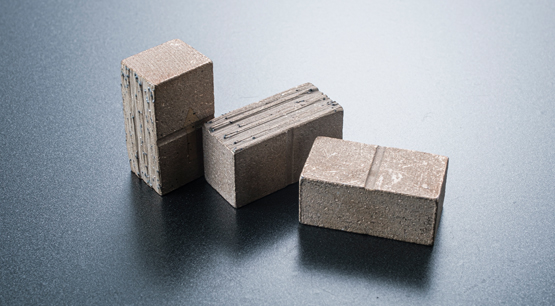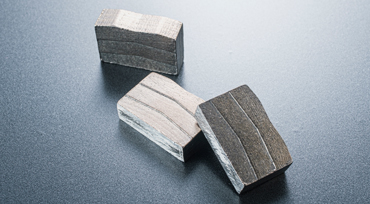Sandwich diamond segment, also known as a triple-layer diamond segment, is a special type of diamond segment with a structure resembling a sandwich, hence the name. The primary characteristic of this blade is that it consists of three layers with different diamond particle distributions, each layer having distinct properties and purposes.
The typical structure of a sandwich diamond segment is as follows:
Double-sided Layers: The double-sided layers are usually composed of larger diamond particles, providing the blade with wear resistance and rigidity. These two layers form the foundation of the blade's performance, ensuring its sharpness and durability.
Intermediate Layer: The intermediate layer contains medium-sized or finer diamond particles used for cutting or grinding materials. These particles contribute to the blade's cutting efficiency. This layer is crucial for achieving high precision in cutting tasks, especially in precision stone processing.
Advantages of a sandwich diamond segment include:
Comprehensive Performance: A sandwich diamond segment combines different-sized diamond particles, resulting in a comprehensive range of performance characteristics. It offers both the wear resistance and rigidity from the double-sided layers and the cutting efficiency from the intermediate layer. This versatility makes it suitable for various cutting and grinding tasks.
High Cutting Efficiency: The intermediate layer's diamond particles provide excellent cutting efficiency. This means that the sandwich diamond segment can cut various materials quickly and effectively, leading to improved production efficiency.
High Precision: When using smaller diamond particles in the intermediate layer, the blade can achieve high-precision cutting. This is crucial for tasks requiring fine cutting and high-quality surface finishes, such as precision stone processing.
Longevity: Thanks to the wear resistance provided by the large diamond particles in the base layers, sandwich diamond segments typically have a longer service life. This reduces the frequency of blade replacements, saving both costs and time.
Versatility: Due to its multi-layered structure, the sandwich diamond segment is adaptable to a wide range of materials, including stone, concrete, metals, and more. This enhances its versatility across various applications.
High Safety: Sandwich diamond segments are designed with safety in mind. Their stable structure reduces the risk of accidental detachment or damage, contributing to operator safety.
Despite these advantages, sandwich diamond segments have some drawbacks, including:
Higher Cost: Manufacturing a sandwich diamond segment is typically more expensive than a single-layer diamond segment. This is mainly due to the use of different-sized and types of diamond particles, as well as the complexity of the manufacturing process.
Lower Cutting Efficiency Compared to Some Multi-Layer Blades: While the cutting efficiency of sandwich diamond segments has improved significantly, it may still be lower than certain multi-layer segmented blades designed for specific applications.
Larger Size: Because of their multi-layer structure, sandwich diamond segments are often thicker, which may limit their use in compact spaces.
Not Suitable for All Materials: Some special materials may not be suitable for sandwich diamond segments because their multi-layer structure may not fully leverage their advantages.
In summary, while sandwich diamond segments offer significant advantages across various applications, their selection and use should be carefully considered based on specific task requirements, weighing both their strengths and weaknesses.

Advantages and disadvantages of sandwich diamond segment
Publish date:2023-09-02 10:40:17 Article From:Linsing diamond tools Clicks:










